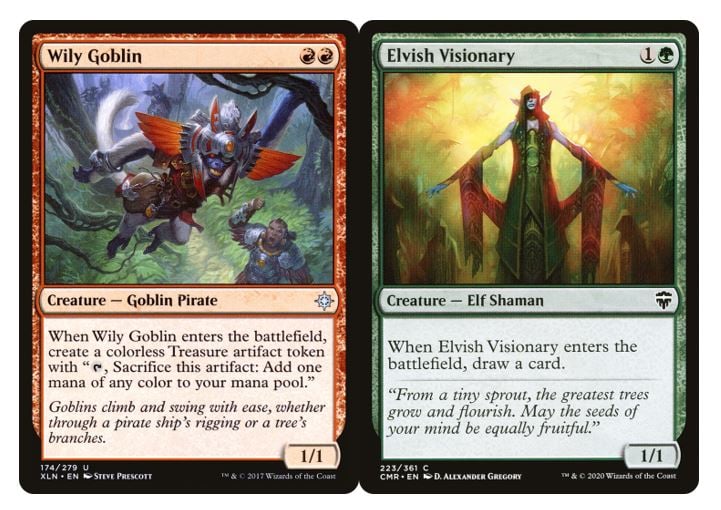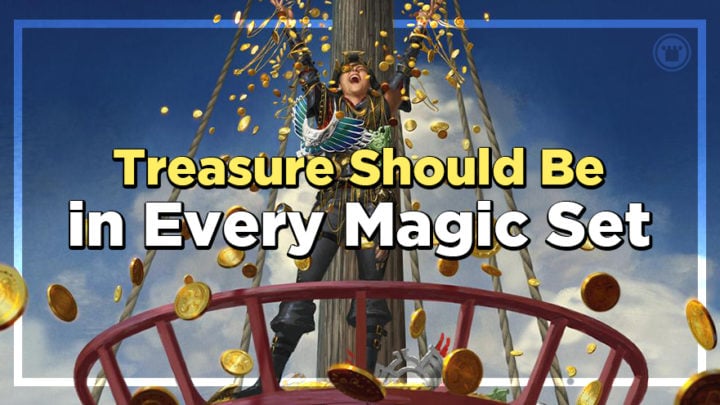After several weeks giving Adventures in the Forgotten Realms a good thrashing, I’ve come to a monumental and unexpected realization: Treasure is the most important mechanic in Magic: The Gathering. And that’s only partially because of all the Immersturm Predators it helps me cast turn three on the play!

Not every mechanic needs to herald a huge evolution in how Magic is designed and played, but the sheer potential of Treasure to improve the average game experience has me wishing it becomes evergreen. That potential is a little more subtle than something like Companions or MDFC’s – obviously, since I’m writing this piece several years after we first created Treasure tokens in Ixalan. But if you take a step back and look at how Treasure functions in the game, you’ll see it’s the missing jigsaw piece to fill a 28-year-old hole in Magic’s otherwise stellar design.
A GAME OF CHANCE AND SKILL
The most immediate way that Treasure can help you enjoy playing Magic is by simply allowing you to play more of it! Especially when produced off one- and two-mana cards, Treasure tokens make for great insurance against the frustrations of mana or color screw. With enough such access, you can even build around Treasure in a way that helps prevent the opposite evil: mana flooding. Just replace a land or two with your cheap Treasure-making creatures if you’re aiming for an extremely low curve!
This ability to help blunt the impact of draw step variance over those key early turns is far from unique among recent Magic mechanics. Even after the radical overhaul that was the London Mulligan, WotC has continued chipping away at the cause of so-called “non-games” – those games of Magic where one player essentially trips over at the starting line and nobody really gets to make interesting choices. Drawing a hand without playable spells has been the lead cause of un-fun and un-competitive Magic since 1993, so it makes sense for WotC to try and design it out of the game however they can. They have done so by making cards more flexible in their cost and effect (adventures, kicker, mutate, foretell), by adding powerful mana sink abilities for when you run out of spells, by massively increasing the amount of card selection across all colors, and by printing more spells which can “double” as a land when needed.

Treasure falls into that final category, alongside the powerful Zendikar Rising MDFC’s. But the MDFC mechanic, by its nature and sheer power level, can only support a limited number of future card designs. Treasure-generating spells are far more conventional and easy to balance or twist around the mechanical themes of each new set. Best of all, they have proven to be available to all five colors. This is especially nice for future Limited environments, which can now untether green from its mandatory role as “the fixing color”. In Strixhaven Limited, the best fixing comes from Prismari Treasure effects (and yes, from Environmental Sciences). In AFR, Treasure again provides an unconventional base for “5c Greed” drafting, this time in base-red-black decks! It’s easy to imagine this pattern continuing as each color settles into its own unique way of relating to treasure, just as WotC has built up signature card draw variants in red, black and green.
NO GOOD DEED GOES UNPUNISHED
I think it’s fairly uncontroversial to say that mana screw and mana flood are undesirable in Magic. But to some degree, they are integral to the way this game is designed and played; you can’t have just the positive half of a bell curve. Attempts to make the unluckiest “non-games” feel more competitive will have a less predictable and often less desirable impact on the average-luck games as well. The swathe of powerful new tools to improve consistency has significantly increased the average pace of Standard, with a variety of not-great implications.
So, even when bravely stepping up to tackle the oldest complaint about Magic, WotC must be cautious about exactly how they implement such draw-smoothing mechanics. I see Treasure as by far the safest and best candidate so far, because of how specifically it matches the needs of a struggling player instead of offering an exploitable general boost.
Obviously, if a player is stuck with an unplayable hand, they need an infusion of either mana or fresh cards to get them out of that spot without missing whole turns. But in those key early turns, you’re far more likely to be bottlenecked on mana (either color or quantity) than on spells in hand. Giving somebody a treasure attached to a two-mana 1/1 will, at worst, let them cast a three drop next turn; at best, they might unlock an immediate off-color play, or jump two steps up the curve if they manage to draw a land next turn. Giving somebody a free card attached to a two-mana 1/1 will, at best, let them make a land drop and pass – not a high-impact play when you’re already behind, and also far from guaranteed.

The same logic also backs up the idea that Treasure is harder to abuse as part of a great draw – which is critical, since that would erase most of the benefits of a smoothing mechanic. Players who have successfully developed to reach their mid or end-game are far less likely to run out of mana than they are to run out of cards to spend it on. Giving them access to lots of discounted cantrips and other draw smoothing produces explosive super-high-velocity decks like the (swiftly banned) Omnath Adventures archetype from ZNR Standard.
By contrast, topdecking a Wily Goblin on turn 7 after you just cast your last Glorybringer is pretty much a whiff… which is good! We do actually need decks to have bad draws, particularly later in the game, to make outcomes less volatile and allow for the kind of tense topdeck wars many players relish.
But even this much-needed, metagame-calming effect is not yet the peak of Treasure’s revolutionary potential…
THE FUTURE OF MAGIC IS IN BANKING
I’m going to apologize in advance for my unfaithfulness: it is time to (briefly) talk about a different card game in the middle of my Magic article!
Legends of Runeterra stands apart from the many, many other “sort of Magic” imitators I’ve tried over the years, in that its developers were able to take three decades of hindsight and iterate on some of the OG’s weaker areas. One such innovation is “spell mana”: if a player ends their turn with mana left unspent, up to three of that leftover mana will be “banked” for their next turn.
This banked mana can only be spent on spells. You can’t ramp out a huge threat for free, but you are able to take a turn off to bank mana for a tempo play (like threat + counterspell) the turn after. Or, crucially, you can miss your two-drop due to unfortunate luck, but still retain the mana for a possible comeback play down the line, transforming this from a bad beat to a temporary resource disadvantage.
Hopefully the parallels between spell mana and Treasure are clear at this point. Both mechanics create a banked mana advantage, which you are not pressured to spend within one turn for the sake of efficiency. Beyond just reducing the disadvantage of a bad draw, these techniques open up the chance for any deck to bluff much more believably, and for more nuanced tempo plays by concentrating mana on a single turn. These play patterns will be familiar to Magic players who played with previous-Standard’s UG Flash – but they are much more enjoyable when both players are able to engage with them by default!
TREASURE IN EVERY COLOR, EVERY SET, AD INFINITUM
So there you have it: my manifesto for the inclusion of Treasure as a universal mana-management mechanic built into the core design of every future set. Treasure is incredibly flexible in both flavor and mechanical execution, with no shortage of different ways to tie into the themes of a set. It synergizes with cards that care about artifacts, about tokens, about sacrificing, about total permanents controlled… and, of course, it naturally deepens strategy around any big-mana, fast-mana, or color-specific designs.
It makes both Limited and Constructed gameplay more fun and more varied, and it has even proven to be relevant in eternal formats (shoutout to Dockside Extortionist!). If WotC were willing to risk permanently and dramatically changing all future games of Magic by introducing Companions, then there shouldn’t be much of an argument about making single-use, bankable mana tokens a part of most every game going forward.
And when they do, I’m sure we will find that the real friends were the Treasures we made along the way.

Tom’s fate was sealed in 7th grade when his friend lent him a pile of commons to play Magic. He quickly picked up Boros and Orzhov decks in Ravnica block and has remained a staunch white magician ever since. A fan of all Constructed formats, he enjoys studying the history of the tournament meta. He specializes in midrange decks, especially Death & Taxes and Martyr Proc. One day, he swears he will win an MCQ with Evershrike. Ask him how at @AWanderingBard, or watch him stream Magic at twitch.tv/TheWanderingBard.

